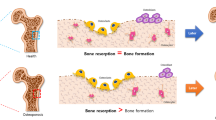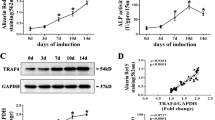Abstract
Previously, we showed that human osteoblasts expressing the human telomerase reverse transcriptase (hTERT) gene exhibited specific survival advantages – the result of breaching the replicative senescence barrier and maintaining the phenotypic and functional properties of primary osteoblasts in vitro over the total replicative capacity of primary osteoblasts. We postulated that rejuvenated osteoblasts may have a potential to correct bone loss or osteopenia in age-related osteoporotic diseases. In the present study, we studied whether telomerized presenescent osteoblasts prevent bone mass loss in vivo. After obtaining the informed consent from a patient with osteoarthritis who underwent the arthroplastic knee surgery, osteoblastic cells were isolated from donor bone sample. We transfected the gene encoding hTERT into human osteoblastic cells. Human bone fragments from a donor were incubated with human hTERT-transfected presenescent (in vitro aged) osteoblasts or mock-transfected presenescent osteoblasts in culture medium containing Matrigel. We subcutaneously implanted human bone fragments with telomerized presenescent osteoblasts or primary presenescent osteoblasts as three-dimensional Matrigel xenografts in severe combined immunodeficiency (SCID) mice (each group: six mice) and analyzed the grafts at 6 weeks after implantation. We also determined whether telomerized osteoblasts affect the bone-forming capacity in vivo, using a well-established mouse transplantation model in which ceramic hydroxyapatite/tricalcium phosphate particles are used as carrier vehicle. Telomerized presenescent osteoblasts were rejuvenated, and maintained the functional properties of young osteoblasts in vitro. Bone mineral content (BMC) and bone mineral density (BMD) were measured by ash weight and dual-energy X-ray absorptiometry, respectively. Whereas BMC and BMD of human bone fragments, which were inoculated with aged osteoblasts in SCID mice, decreased with time, telomerized presenescent osteoblasts maintained the BMC and BMD of human bone fragments, indicating that telomerized and rejuvenated osteoblasts may be functional to prevent bone mass loss in vivo. In xenogenic transplants, telomerized osteoblasts generated more bone tissue with lamellar bone structure and cellular components, than did control osteoblasts. These findings suggest that telomerized/rejuvenated presenescent osteoblasts may be used in the development of tissue engineering or cell-based therapy for bone regeneration and repair.
This is a preview of subscription content, access via your institution
Access options
Subscribe to this journal
Receive 12 print issues and online access
$259.00 per year
only $21.58 per issue
Buy this article
- Purchase on Springer Link
- Instant access to full article PDF
Prices may be subject to local taxes which are calculated during checkout







Similar content being viewed by others
References
Blackburn EH . Structure and function of telomeres. Nature 1991; 350: 569–573.
Lindsey J et al. In vivo loss of telomeric repeats with age in humans. Mutat Res 1991; 256: 45–48.
Vaziri H et al. Loss of telomeric DNA during aging of normal and trisomy 21 human lymphocytes. Am J Hum Genet 1993; 52: 661–667.
Harley CB, Futcher AB, Greider CW . Telomeres shorten during aging of human fibroblasts. Nature 1990; 345: 458–460.
Bodnar AG et al. Extension of life-span by introduction of telmerase into normal human cells. Science 1998; 279: 349–352.
Nakamura TM et al. Telomerase catalytic subunit homologs from fission yeast and human. Science 1997; 277: 955–959.
Meyerson M et al. hEST2, the putative human telomerase catalytic subunit gene is up-regulated in tumor cells and during immortalization. Cell 1997; 90: 785–795.
Harrington L et al. Human telomerase contains evolutionarily conserved catalytic and structural subunits. Gene Dev 1997; 11: 3109–3115.
Kilian A et al. Isolation of a candidate human telomerase catalytic subunit gene, which reveals complex splicing patterns in different cell types. Hum Mol Genet 1997; 6: 2011–2019.
Jiang X-R et al. Telomerase expression in human somatic cells does not induce charges associated with a transformed phenotype. Nat Genet 1999; 21: 111–113.
Morales CM et al. Absence of cancer-associated changes in human fibroblasts immortalized with telomerase. Nat Genet 1999; 21: 115–118.
Shi S et al. Bone formation by human postnatal bone marrow stromal stem cells is enhanced by telomerase expression. Nat Biotechnol 2002; 20: 587–591.
Yudoh K et al. Reconstituting telomerase activity using the telomerase catalytic subunit prevents the telomere shorting and replicative senescence in human osteoblasts. J Bone Miner Res 2001; 16: 1453–1464.
Shay JW, Wright WE . The use of telomerized cells for tissue engineering. Nat Biotechnol 2000; 18: 22–23.
Thomas M, Yang L, Hornsby PJ . Formation of functional tissue from transplanted adrenocortical cells expressing telomerase reverse transcriptase. Nat Biotechnol 2000; 18: 39–42.
Kiyono T et al. Both Rb/p16 INK 4a inactivation and telomerase activity are required to immortalize human epithelial cells. Nature 1998; 396: 84–88.
Counter CM et al. Dissociation among in vitro telomerase activity, telomere maintenance, and cellular immortalization. Proc Natl Acad Sci USA 1998; 95: 14723–14728.
Seigneurin-Venin S, Bernard V, Tremblay JP . Telomerase allows the immortalization of T antigen-positive DMD myoblasts: a new source of cells for gene transfer application. Gene Therapy 2000; 7: 619–623.
Zhu J, Wang H, Bishop JM, Blackburn EH . Telomerase extends the lifespan of virus-transformed human cells without net telomere lengthening. Proc Natl Acad Sci USA 1999; 96: 3723–3728.
Halvorsen TL, Leibowitz G, Levine F . Telomerase activity is sufficient to allow transformed cells to escape from crisis. Mol Cell Biol 1999; 19: 1864–1870.
Darimont C et al. SV40 T antigen and telomerase are required to obtain immortalized human adult bone cells without loss of the differentiated phenotype. Cell Growth Differ 2002; 13: 59–67.
Martinez ME et al. Influence of skeletal site of origin and donor age on osteoblastic cell growth and differentiation. Calcif Tissue Int 1999; 261: 280–286.
Jilka RL et al. Increased bone formation by prevention of osteoblast apoptosis with parathyroid hormone. J Clin Invest 1999; 104: 439–446.
Pfeilschifter J et al. Mitogenic responsiveness of human bone cells in vitro to hormones and growth factors decreases with age. J Bone Miner Res 1993; 8: 707–717.
Sabokbar A, Millett PJ, Myer B, Rushton N . A rapid quantitative assay for measuring alkaline phosphatase activity in osteoblastic cells in vitro. Bone Miner 1994; 27: 57–67.
Smith JR, Braunschweiger KI . Growth of human embryonic fibroblasts at clonal density: concordance with results from mass cultures. J Cell Physiol 1978; 98: 597–602.
Kim NW et al. Specific association of human telomerase activity with immortal cells and cancer. Science 1994; 266: 2011–2015.
Masuda H et al. Bone mass loss due to estrogen deficiency is compensated in transgenic mice overexpressing human osteoblast stimulating factor-1. Biochem Biophys Res Commun 1997; 238: 528–533.
Author information
Authors and Affiliations
Additional information
Supported by a Grant in Aid for Fundamental Comprehensive Research on Long-term Chronic Disease (Department of Rheumatoid Arthritis) from the Japanese Ministry of Health & Welfare
Rights and permissions
About this article
Cite this article
Yudoh, K., Nishioka, K. Telomerized presenescent osteoblasts prevent bone mass loss in vivo. Gene Ther 11, 909–915 (2004). https://doi.org/10.1038/sj.gt.3302234
Received:
Accepted:
Published:
Issue Date:
DOI: https://doi.org/10.1038/sj.gt.3302234
Keywords
This article is cited by
-
Targeting Cell Senescence for the Treatment of Age-Related Bone Loss
Current Osteoporosis Reports (2019)
-
Senescent cells: SASPected drivers of age-related pathologies
Biogerontology (2014)
-
The use of hTERT-immortalized cells in tissue engineering
Cytotechnology (2004)



